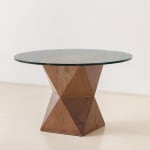









José Zanine Caldas
Dining Table, from Móveis Denúncia series, 1970s
| Original condition |
Solid wood, Glass
Solid wood, Glass
H 29.6 in. x Ø 46.46 in.
H 75.2 cm x Ø 118 cm
H 75.2 cm x Ø 118 cm
BO.ZAN.006-001
Further images
-
(View a larger image of thumbnail 1
)

-
(View a larger image of thumbnail 2
)

-
(View a larger image of thumbnail 3
)

-
(View a larger image of thumbnail 4
)

-
(View a larger image of thumbnail 5
)

-
(View a larger image of thumbnail 6
)

-
(View a larger image of thumbnail 7
)

-
(View a larger image of thumbnail 8
)

-
(View a larger image of thumbnail 9
)

-
(View a larger image of thumbnail 10
)

Jose Zanine Caldas (1919-2001) was a self-taught artist, designer, and architect, born in Bahia, Brazil. At age twenty, he opened an architectural scale model workshop in Rio de Janeiro, working...
Jose Zanine Caldas (1919-2001) was a self-taught artist, designer, and architect, born in Bahia, Brazil. At age twenty, he opened an architectural scale model workshop in Rio de Janeiro, working with modernist pioneers such as Lucio Costa and Oscar Niemeyer.
In the 1970s, seeing the wood leftover from deforestation, Zanine decided to make use of wood scrap and, at the same time, bring attention to the environmental destruction of the region. That was when he created his "protest furniture." He believed his furniture would be evidence for future generations of the existence of large trees in the original Atlantic Forest. To that end, he kept the trunks and roots in their natural shapes and sizes.
Inspired by the local craftsmen who carved boats and furniture from felled trees, Zanine began experimenting with carving large sculptural works, which became the focus of his later career. Zanine wrote extensively about his connection to the forest and tried, whenever possible, to either use already felled trees or to plant a tree for each one he used.
In the 1970s, seeing the wood leftover from deforestation, Zanine decided to make use of wood scrap and, at the same time, bring attention to the environmental destruction of the region. That was when he created his "protest furniture." He believed his furniture would be evidence for future generations of the existence of large trees in the original Atlantic Forest. To that end, he kept the trunks and roots in their natural shapes and sizes.
Inspired by the local craftsmen who carved boats and furniture from felled trees, Zanine began experimenting with carving large sculptural works, which became the focus of his later career. Zanine wrote extensively about his connection to the forest and tried, whenever possible, to either use already felled trees or to plant a tree for each one he used.